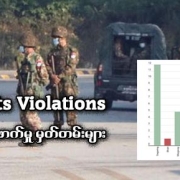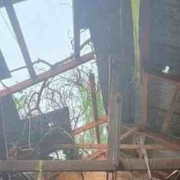Junta bombardment strands 1,000 civilians in Shan state township
The military is on the offensive to retake Hsihseng from ethnic Pa-O rebels.
More than 1,000 civilians are trapped amid heavy clashes between Myanmar’s military and ethnic Pa-O rebels in southern Shan state’s Hsiheng township, which the junta has been trying to retake since Monday, according to residents.
The fighting to recapture Hsihseng comes amid a wider push by Myanmar’s various armed resistance factions that increasingly has the junta on the ropes across the country, including in neighboring Sagaing region, where the People’s Defense Force said it is close to taking over a township near the region’s largest city, Monywa.
The Pa-O National Liberation Army, or PNLA, seized Hsihseng township from a pro-junta militia known as the Pa-O National Organization, or PNO, on Jan. 22.
Beginning on March 3, a joint force of junta troops and soldiers from the Pa-O National Army – the armed wing of the PNO – responded with nearly 100 attacks on Mae Nal Taung district between Hsihseng, Ho Pong and Mong Pun townships using heavy weapons and drones in fighting that has killed 47 civilians and injured around 60 others, according to the PNLA.
Hsihseng’s main market was also set ablaze, and a total of 153 buildings – including some 15 religious structures and a hospital – were destroyed, the rights group Pa-O Youth Organization told RFA Burmese.
A resident of Hsihseng who, like others interviewed for this report, spoke on condition of anonymity due to security concerns, said that fighting was underway Wednesday in the northern part of the township, which lies some 85 kilometers (53 miles) south of Shan state’s capital and largest city, Taunggyi.
“When [junta troops] advanced, the battle resumed,” he said, adding that some houses had been burnt down. “The military is continuously firing artillery shells. Flames can be seen at [nearby] Mya Kan Thar ward from our village.”
The resident said the military had carried out airstrikes on the area and that junta troops in a nearby village had fired around 20 artillery barrages on Hsihseng.
Nang, the spokesperson for the Pa-O Youth Organization, told RFA that “more than 1,000 civilians” from Aung Chan Thar and Thiri wards, and nearby villages in Hsihseng, have been unable to escape the fighting.
“Some residents haven’t fled [the seat of] Hsihseng. The exact number can’t be confirmed, but more than 1,000 people are trapped there,” Nang said. “In the past few days, many residents have fled into the jungle to take shelter from the military’s aerial bombardment.”
Nang said that most of those trapped by the fighting are “common laborers” who were attempting to guard their homes or had returned to the area to check on their belongings before the fighting broke out on Monday.
‘Too dangerous’ for rescue
A volunteer rescue worker told RFA that it was impossible for his group to evacuate those still inside.
“The resistance forces have blocked the roads, so we cannot enter the town to rescue the remaining trapped civilians,” he said. “They won’t let us enter because they said it is too dangerous for us.”

Other rescue workers said Wednesday that some of the trapped civilians were trying to avoid the fighting by gathering in paddy fields in southern Hsihseng township.
A PNLA information officer confirmed to RFA that the focus of the military’s attacks in Mae Nal Taung district – between Hsihseng, Ho Pong and Mong Pun – is home to “many residents.”
“We are still investigating the extent of losses and damage,” he said. “At least eight houses were destroyed by military artillery shelling, from what we can tell, but a lot of the damage occurred in areas beyond our reach.”
The junta has yet to release any information on the fighting in Hsihseng and attempts by RFA to contact Khun Thein Maung, the junta’s minister of economy and spokesperson for Shan state, went unanswered.
While the PNLA is a signatory to Myanmar’s Nationwide Ceasefire Agreement, or NCA, a schism within the ethnic army and its political wing, the Pa-O National Liberation Organization, has led to clashes with the junta.
The NCA was introduced in 2015 to end years of fighting over minority rights and self-determination. Since then, some 10 ethnic groups have signed the agreement.
Prior to the PNLA takeover, Hsihseng was under junta control as a township self-administered by the PNO. On Jan 21, a day before its capture, the PNO’s armed wing carried out an inspection of a PNLA convoy, seizing weapons and arresting some of the group’s officers.
Fight for Kani township
Meanwhile, in neighboring Sagaing region, the fight for control of Kani township has reached a crescendo since the anti-junta People’s Defense Forces, or PDF – ordinary civilians who have taken up arms against the junta – attacked the township police station, general administrative office, school and several military positions on March 2.
Kani is located a mere 60 kilometers (37 miles) north of Monywa, Sagaing’s largest city and the headquarters of the military’s northwestern command. It is along the key Chindwin River waterway, and on Wednesday the junta responded to the attacks with at least eight airstrikes from combat helicopters and fighter jets on the township’s wards and villages, according to the PDF.
Despite the heavy retaliation, PDF member Myat Ko told RFA that “only one military outpost is left to be captured” until his group will assume total control of the township.
Myat Ko said the number of pro-junta Pyu Saw Htee militia members on the ground in Kani number far greater than junta troops, and that the military had carried out “more than 20 aerial attacks” on the township since the fighting began.
He said the military is now deploying troops to Kani via helicopter, although the exact number is unknown, adding that the PDF had arrested some police officers and nearly 40 junta civil service staff during the six-day battle.
RFA was unable to independently verify the claims.

The Kani PDF said that two of its fighters were killed in the fighting since March 2, while the military “suffered high casualties.” It said nearly 200 junta fighters, including troops, police and Pyu Saw Htee members, were stationed in the township.
At least one civilian – a 70-year-old resident of Min Kone village – was killed in a military aerial attack on March 4, according to residents.
Around 50 civilians who had been trapped inside the town during the fighting were evacuated by the PDF on March 6, they said.
Nearly everyone in town has fled to safer areas, although some elderly people remain, they added.
Attempts to contact Sai Naing Naing Kyaw, the junta’s minister of ethnic affairs and spokesperson for Sagaing region went unanswered Thursday.
Anti-junta forces in Sagaing region have captured Kawlin, Mawlu, Kham Pet and Shwe Pyi Aye townships, although the military retook Kawlin after conducting a major offensive in February.
Tens of thousands displaced
More than 150,000 civilians have fled 15 townships in Sagaing amid military offensives between Jan. 1 and Feb. 15 alone, RFA has learned.
They include 21,000 in Monywa, 7,000 in Myaung, 15,000 in Taze, 3,000 in Maw Laik, 8,000 in Kantbalu, 13,000 in Yinmarbin, more than 3,000 in Butalin, more than 50,000 in Ye-U, 1,000 in Pinlebu, nearly 3,000 in Salingyi, nearly 2,500 in Myinmu, more than 8,000 in Khin-U, more than 3,000 in Homelin, and over 15,000 in Kawlin townships.

Many of the displaced are suffering from shortages of food and clean water, and medical supplies, and are sheltering in poor conditions.
While Sai Naing Naing, the junta’s social affairs minister and spokesperson for Sagaing region, told RFA that junta authorities have provided aid to more than 1,500 displaced in Homelin township.
But aid workers disputed his claims, saying that the junta provides no support to those displaced by conflict.
The U.N. Office for the Coordination of Humanitarian Affairs recently reported that there are nearly 2.7 million displaced people across Myanmar.







